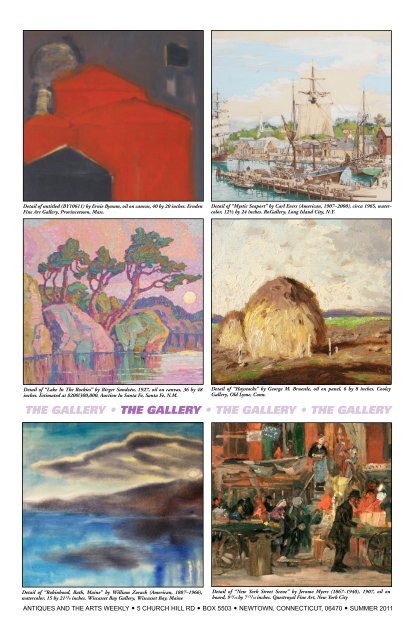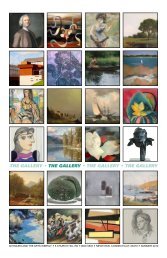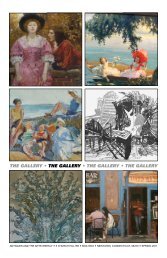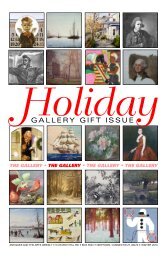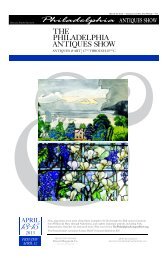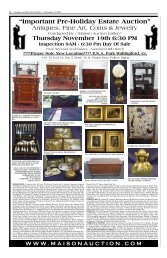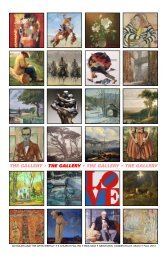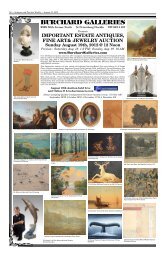Detail of “Mystic Seaport” by Carl Evers - Antiques and the Arts Online
Detail of “Mystic Seaport” by Carl Evers - Antiques and the Arts Online
Detail of “Mystic Seaport” by Carl Evers - Antiques and the Arts Online
Create successful ePaper yourself
Turn your PDF publications into a flip-book with our unique Google optimized e-Paper software.
<strong>Detail</strong> <strong>of</strong> untitled (BY10611) <strong>by</strong> Ernie Bynum, oil on canvas, 40 <strong>by</strong> 20 inches. Ernden<br />
Fine Art Gallery, Provincetown, Mass.<br />
<strong>Detail</strong> <strong>of</strong> “Lake In The Rockies” <strong>by</strong> Birger S<strong>and</strong>zén, 1927, oil on canvas, 36 <strong>by</strong> 48<br />
inches. Estimated at $200/300,000. Auction In Santa Fe, Santa Fe, N.M.<br />
THE GALLERY THE GALLERY THE GALLERY THE GALLERY<br />
<strong>Detail</strong> <strong>of</strong> “Robinhood, Bath, Maine” <strong>by</strong> William Zorach (American, 1887–1966),<br />
watercolor, 15 <strong>by</strong> 21 3/8 inches. Wiscasset Bay Gallery, Wiscasset Bay, Maine<br />
<strong>Detail</strong> <strong>of</strong> <strong>“Mystic</strong> <strong>Seaport”</strong> <strong>by</strong> <strong>Carl</strong> <strong>Evers</strong> (American, 1907–2000), circa 1965, watercolor,<br />
12½ <strong>by</strong> 24 inches. RoGallery, Long Isl<strong>and</strong> City, N.Y.<br />
<strong>Detail</strong> <strong>of</strong> “Haystacks” <strong>by</strong> George M. Bruestle, oil on panel, 6 <strong>by</strong> 8 inches. Cooley<br />
Gallery, Old Lyme, Conn.<br />
<strong>Detail</strong> <strong>of</strong> “New York Street Scene” <strong>by</strong> Jerome Myers (1867–1940), 1907, oil on<br />
board, 9 3/16 <strong>by</strong> 7 13/16 inches. Questroyal Fine Art, New York City<br />
ANTIQUES AND THE ARTS WEEKLY 5 CHURCH HILL RD BOX 5503 NEWTOWN, CONNECTICUT, 06470 SUMMER 2011
2 - THE GALLERY July 15, 2011 — <strong>Antiques</strong> <strong>and</strong> The <strong>Arts</strong> Weekly<br />
WORCESTER, MASS. — “If you are<br />
fair with a collector <strong>and</strong> honest, you will<br />
have that collector for life. I have had customers<br />
for 20 to 30 years. I have filled<br />
<strong>the</strong>ir houses up with paintings,” said art<br />
dealer Bill Union, owner <strong>of</strong> Art <strong>and</strong><br />
Antique Gallery.<br />
Union <strong>of</strong>fers a “buy-back” guarantee. If a<br />
collector is not happy with an art purchase<br />
for any reason, Union will buy it back for<br />
<strong>the</strong> same price. If <strong>the</strong> painting comes back<br />
to him more than a year after he sold it,<br />
Union pays a ten percent increase over <strong>the</strong><br />
initial sales price. “That is a ten percent<br />
increase for life, not per year,” he quipped.<br />
Also, a pr<strong>of</strong>essional dealer is expected to<br />
know what <strong>the</strong>y are looking at when <strong>the</strong>y<br />
are inspecting a painting for purchase, so<br />
<strong>the</strong> buy-back guarantee does not apply to<br />
dealer purchases.<br />
Art <strong>and</strong> Antique Gallery also has a 24hour<br />
evaluation period for works <strong>of</strong> art that<br />
are shipped. This is especially important if a<br />
collector is purchasing a painting based on<br />
an image sent through email or seen on a<br />
website (Art <strong>and</strong> Antique Gallery is listed<br />
on AskArt.com). Once a painting is<br />
received, if <strong>the</strong> customer does not like <strong>the</strong><br />
work for any reason, <strong>the</strong>y can ship it back.<br />
Although Union declares that he is not in<br />
<strong>the</strong> “finance business,” he will extend terms<br />
for paying over a three-month time period<br />
in certain cases. “Any longer than that <strong>and</strong><br />
you probably should not be buying art, you<br />
BY DENNIS COSTIN<br />
OWNER, ERNDEN FINE ART GALLERY<br />
Ernie Bynum speaks with <strong>the</strong> voice <strong>of</strong> a colorist concentrating<br />
not on painting pretty pictures but on<br />
painting images that relate to his past, but in a manner<br />
that creates mystery <strong>and</strong> intrigue. He applies layer<br />
upon layer <strong>of</strong> paint, reductive in imagery, yet expansive<br />
<strong>and</strong> dynamic in its depth <strong>of</strong> color. A whole dream-like<br />
world resonates with inner life <strong>and</strong> inner light, drawing<br />
<strong>the</strong> viewer through <strong>the</strong> plane into this deep, mysterious<br />
essence.<br />
Over time Bynum’s work has become much less figurative.<br />
A passing suggestion <strong>of</strong> image becomes an<br />
expression <strong>of</strong> color <strong>and</strong> light. His shapes seem to dissolve<br />
into space; <strong>and</strong> whereas in <strong>the</strong> past, one could<br />
more clearly see <strong>the</strong> skiff, cottage <strong>and</strong> wharf <strong>and</strong> water<br />
tower, <strong>and</strong> now <strong>the</strong> eye catches only a furtive glimpse<br />
<strong>of</strong> <strong>the</strong>se images, receding in <strong>the</strong> exp<strong>and</strong>ing field <strong>of</strong><br />
color. There are no horizon lines in Bynum’s pieces<br />
because he continues to reach for <strong>the</strong> ultimate in a<br />
painting; creating what could be a l<strong>and</strong>scape, a still life<br />
or images <strong>of</strong> animals that beckon to <strong>the</strong> viewer’s imagination.<br />
While Bynum continues to work on less <strong>and</strong> less figuration<br />
in his work, with some <strong>of</strong> his newly completed<br />
work he has drawn on imagery he started working on<br />
19 years ago; a cow, a rooster, a horse, flowers, all more<br />
abstract than figurative but which continue to speak to<br />
<strong>the</strong> diversity <strong>of</strong> his creative genius.<br />
Bynum states, “Painting is a process that begins with<br />
no preconceived notions <strong>of</strong> what I will paint. I let my<br />
subconscious take over <strong>and</strong> begin working on my compositions<br />
as ideas begin to flow. I do not rely on tech-<br />
My Kind Of Art<br />
Art dealer Bill Union <strong>of</strong> Antique <strong>and</strong> Art Gallery, Worcester, Mass., next to an oil<br />
painting <strong>by</strong> Constantine Kluge titled “A Beautiful Day.”<br />
should be buying food,” said Union. “Art is<br />
a luxury. Paintings are not a necessity.”<br />
Necessity or not, Union does think <strong>of</strong><br />
paintings as a good investment, with one<br />
important word <strong>of</strong> advice: “Never buy anything<br />
you don’t like.” For him, that means<br />
paintings from <strong>the</strong> Nineteenth <strong>and</strong> early<br />
Twentieth Centuries, which he considers<br />
to be <strong>the</strong> “sweet spot” <strong>of</strong> <strong>the</strong> art market. “If<br />
you’ve noticed, it is getting harder to find.<br />
Dem<strong>and</strong> is up. It’s that wonderful oldfashioned<br />
school <strong>of</strong> art that I see holding<br />
up over time. My kind <strong>of</strong> art.”<br />
Union believes strongly in <strong>the</strong> affinity <strong>of</strong><br />
<strong>the</strong> antiques market <strong>and</strong> <strong>the</strong> art market. “I<br />
was <strong>the</strong> first paintings dealer to set up at<br />
antiques shows. There were guys who sold<br />
antiques with a few pictures mixed in, but<br />
Ernie Bynum: Layers <strong>of</strong> Mystery<br />
Ernie Bynum, “ID” (BY11211), oil on canvas, 36 <strong>by</strong><br />
24 inches.<br />
nique but ra<strong>the</strong>r on my ideas <strong>and</strong> sense <strong>of</strong> composition.<br />
Using both brush <strong>and</strong> palette knife, I build up<br />
colors, so that in <strong>the</strong> process images emerge, unique to<br />
in <strong>the</strong> early days, I was <strong>the</strong> only guy at<br />
antiques shows who sold only artwork —<br />
starting with <strong>the</strong> old New Haven Coliseum<br />
show in <strong>the</strong> 1970s. At <strong>the</strong> time, that show<br />
was <strong>the</strong> oldest antiques show in <strong>the</strong> country.<br />
Now, more <strong>and</strong> more paintings dealers<br />
are flocking to antiques shows. Miami<br />
Beach is now 60 percent art dealers. It’s<br />
known for art.”<br />
Union buys <strong>and</strong> sells paintings every day.<br />
“I have a lot <strong>of</strong> things happening all <strong>the</strong><br />
time,” he said. This constant activity, coupled<br />
with his willingness to let things go at<br />
reasonable prices, means that a good piece<br />
in his h<strong>and</strong>s generally will not last long<br />
before it is sold. He has a full schedule <strong>of</strong><br />
antiques shows lined up, including <strong>the</strong> Baltimore<br />
<strong>Antiques</strong> Show; Madison Bouckville,<br />
in Bouckville, N.Y.; New Hampshire Week<br />
in Manchester; Birchwood Manor <strong>Antiques</strong><br />
Show in Whippany, N.J.; <strong>the</strong> Farmington<br />
<strong>Antiques</strong> Show (now at <strong>the</strong> Harwinton,<br />
Conn. Fairgrounds); The Pier <strong>Antiques</strong><br />
Show in New York City; <strong>and</strong> <strong>the</strong> Connecticut<br />
Fall <strong>Antiques</strong> Show in Hartford.<br />
Art shoppers do not have to wait for an<br />
antiques show to meet Union <strong>and</strong> see <strong>the</strong><br />
vast number <strong>of</strong> paintings he has at a given<br />
time. “People should know that <strong>the</strong>y can<br />
come to me directly,” said Union.<br />
Art <strong>and</strong> Antique Gallery is at 4 Old English<br />
Road in Worcester, Mass. To reach Bill Union,<br />
call 508-259-4694 or email<br />
wmunion@charter.net.<br />
each painting, imagery that resonates with warmth,<br />
sensitivity, peacefulness <strong>and</strong> tranquility. For me, my<br />
palette is merely for experimentation. I would never be<br />
able to mix <strong>the</strong> same color twice. Each new day, I am<br />
challenged to mix new colors.”<br />
These paintings originate at <strong>the</strong> intersection <strong>of</strong> psychological<br />
<strong>and</strong> literal l<strong>and</strong>scapes. Through his unique<br />
vocabulary, Bynum creates work that is a compelling<br />
union <strong>of</strong> luminous color <strong>and</strong> pr<strong>of</strong>ound affect.<br />
He draws inspiration from his experience <strong>of</strong> nature<br />
<strong>and</strong> place, from his youth in <strong>the</strong> pine forests <strong>of</strong> North<br />
Carolina, his exposure as a teenager to coastal Connecticut<br />
<strong>and</strong> Cape Cod, his adult years spent in New<br />
Mexico, <strong>the</strong> Caribbean <strong>and</strong> West Africa, <strong>and</strong> now in<br />
Provincetown, New York City <strong>and</strong> Connecticut. The<br />
separation <strong>of</strong> nature <strong>and</strong> spirit is not a reality for<br />
Bynum. For Bynum, it cannot be discussed; it must be<br />
painted.<br />
Bynum received his BS degree from Fordham University<br />
in New York City. He concluded his graduate<br />
studies at <strong>the</strong> University <strong>of</strong> Chicago, graduating Cum<br />
Laude with an MA. Prior to painting full time, Bynum<br />
was a psycho<strong>the</strong>rapist.<br />
Bynum’s work has been exhibited in both solo <strong>and</strong><br />
group exhibitions in Provincetown; New York City;<br />
Arroyo Seco, New Mexico; San Juan, Puerto Rico; <strong>and</strong><br />
Saba, Ne<strong>the</strong>rl<strong>and</strong>s Antilles. His paintings are in private<br />
<strong>and</strong> corporate collections throughout <strong>the</strong> United States,<br />
in <strong>the</strong> Caribbean, Europe <strong>and</strong> Australia.<br />
Ernden Fine Art Gallery is at 397 Commercial Street in<br />
Provincetown, Mass. For information on Ernie Bynum’s<br />
work, call 508-487-6700 or email erndengallery@att.net.<br />
The gallery’s website is www.erndengallery.com.
<strong>Antiques</strong> <strong>and</strong> The <strong>Arts</strong> Weekly — July 15, 2011<br />
THE WIN/WIN PROPOSITION<br />
QUESTROYAL TO SELL 60 PAINTINGS BELOW COST<br />
Visit www.questroyalfineart.com/special<br />
You might think that a gallery willing to sell 60 paintings at a loss is ei<strong>the</strong>r experiencing financial difficulty<br />
(this is our best year <strong>of</strong> <strong>the</strong> last ten) or simply selling its mistakes (60 would be a lot <strong>of</strong> “mistakes”).<br />
This is our reasoning: Questroyal owns <strong>the</strong> paintings it sells—few dealers do. We have over 400 American<br />
paintings <strong>and</strong> no intention to stop buying; however, our inventory would benefit from greater diversity <strong>and</strong> we<br />
want to augment our Modernist <strong>and</strong> Impressionist selections. It’s best to buy in <strong>the</strong> summer because it’s <strong>the</strong><br />
slowest part <strong>of</strong> <strong>the</strong> year <strong>and</strong> we will use our proceeds to immediately acquire new paintings. Our losses will be<br />
<strong>of</strong>fset <strong>by</strong> <strong>the</strong> tax deductions <strong>the</strong>y produce <strong>and</strong> you will have an opportunity to buy paintings below our cost. It is<br />
a win/win proposition.<br />
We believe in <strong>the</strong>se paintings. They were selected after careful consideration <strong>and</strong>, without reservation, we can<br />
say that each is an excellent value in its respective price range.<br />
You may return any <strong>of</strong> <strong>the</strong> paintings <strong>of</strong>fered on special within one year <strong>of</strong> your purchase for a full refund.<br />
OFFER ENDS AUGUST 31, 2011<br />
Clockwise from top left: Henry Rittenberg (1879-1969) The Red Lacquer Box Cost: $19,500 Your Price: $16,500; John Williamson (1826–<br />
1885) Indian Summer Cost: $35,000 Your Price: $27,500; Birge Harrison (1854–1929) Sunset from Quebec Cost: $52,000 Your Price: $45,000;<br />
Jonas Lie (1880–1940) The Chapel, Kamp Kill Kare, 1930 Cost: $35,000 Your Price: $30,000; Frank Anderson (1844–1891) Two Trees in Autumn<br />
Cost: $16,000 Your Price: $14,000; Alex<strong>and</strong>er Wyant (1836–1892) Passing Storm Cost: $10,000 Your Price: $7,500<br />
Questroyal Fine Art, llc<br />
Important American Paintings<br />
903 Park Avenue (at 79th Street), Suite 3A&B, New York, NY 10075 T:(212) 744-3586 F:(212) 585-3828<br />
Hours: Monday–Friday 10–6, Saturday 10–5 <strong>and</strong> <strong>by</strong> appointment<br />
Email: gallery@questroyalfineart.com www.questroyalfineart.com<br />
THE GALLERY — 3
4 - THE GALLERY July 15, 2011 — <strong>Antiques</strong> <strong>and</strong> The <strong>Arts</strong> Weekly<br />
Paul Sawyier (1865–1917), “Lower New York from Grace &<br />
Co.’s Pier,” oil on artist’s board, 9 1 /8 <strong>by</strong> 12 1 /8 inches. Signed<br />
lower right: Paul Sawyier; inscribed on verso: Lower New York<br />
from Grace & Co. Pier.<br />
Famed Impressionist, Mary Cassat, once said to fellow<br />
painter, J. Alden Weir, “At some future time I shall see New<br />
York as <strong>the</strong> artist’s ground. I think you will create an American<br />
school.” 1 It is precisely this focus on <strong>the</strong> city <strong>of</strong> New<br />
York that helped a select few late Nineteenth <strong>and</strong> early<br />
Twentieth Century artists define <strong>the</strong>ir Impressionist style as<br />
uniquely American. While many American Impressionists<br />
attempted to imitate <strong>the</strong>ir European contemporaries, both<br />
in terms <strong>of</strong> style <strong>and</strong> subject matter, this group <strong>of</strong> painters<br />
elected not to simply recreate Degas’s ballerinas or Renoir’s<br />
party scenes, instead, <strong>the</strong>y firmly grounded <strong>the</strong>mselves as<br />
masters in <strong>the</strong> canon <strong>of</strong> American art through <strong>the</strong>ir subject<br />
matter — <strong>the</strong> incomparable cityscape <strong>of</strong> New York.<br />
Questroyal Fine Art is proud to have in our collection<br />
four hidden gems <strong>by</strong> some <strong>of</strong> <strong>the</strong> premiere innovators <strong>of</strong><br />
American Impressionism, all <strong>of</strong> whom chose New York<br />
City as <strong>the</strong>ir inspiration: Ernest Lawson’s “Inwood,” Paul<br />
Sawyier’s “Lower New York from Grace & Co’s Pier,” Guy<br />
<strong>Carl</strong>eton Wiggins’s “Empire State Building, Winter” <strong>and</strong><br />
Jerome Myers’s “New York Street Scene,” all illustrating a<br />
movement towards an exclusively American form <strong>of</strong> expression.<br />
Ra<strong>the</strong>r than align with <strong>the</strong> focus <strong>of</strong> The Ashcan<br />
School, which, in its depictions <strong>of</strong> New York, strove to<br />
expose an element <strong>of</strong> social realism, <strong>the</strong>se four artists painted<br />
New York to celebrate <strong>the</strong>ir delight in <strong>the</strong> generally overlooked<br />
beauty <strong>of</strong> <strong>the</strong> city.<br />
One such painting is “Inwood” <strong>by</strong> Ernest Lawson, a former<br />
student <strong>of</strong> J. Alden Weir <strong>and</strong> an American Impressionist,<br />
as well as an original member <strong>of</strong> The Eight. The Ca<strong>the</strong>dral<br />
at Rouen may have inspired Monet to experiment with<br />
paint technique <strong>and</strong> color, but an equally deep study in<br />
impasto <strong>and</strong> abstraction can be found in Lawson’s<br />
“Inwood.” In this painting, Lawson transforms <strong>the</strong> busy<br />
city into a peaceful <strong>and</strong> serene, almost organic space. Calm<br />
as <strong>the</strong> scene may be, however, <strong>the</strong>re is a sense <strong>of</strong> anticipation<br />
— as if <strong>the</strong> solitary man guiding his horse <strong>and</strong> carriage<br />
must finish his morning routine before <strong>the</strong> city comes alive<br />
Ernest Lawson (1873–1939), “Inwood, Upper Washington<br />
Heights,” oil on canvas 17 5 /8 <strong>by</strong> 21 1 /8 inches.<br />
New York, New York<br />
BY ALEXANDRA GINIGER, MARKETING & RESEARCH ASSOCIATE, QUESTROYAL FINE ART, LLC<br />
SANTA FE, N.M. — All eyes will be upon Santa Fe on<br />
August 13–14 when 11 important works <strong>by</strong> Birger S<strong>and</strong>zén<br />
(1871–1954) make <strong>the</strong>ir way across <strong>the</strong> auction block during<br />
<strong>the</strong> 7th annual Auction In Santa Fe (AISF). The S<strong>and</strong>zén<br />
pieces were selected <strong>by</strong> <strong>the</strong> Bethany College Art Committee,<br />
<strong>the</strong>n deaccessioned to be sold to support <strong>the</strong> general scholarship<br />
fund; student scholarships total more than $6 million<br />
per year. The sale will feature one <strong>of</strong> <strong>the</strong> largest S<strong>and</strong>zén oils<br />
ever to be <strong>of</strong>fered at auction, a 60-<strong>by</strong>-80-inch painting titled<br />
“Summertime in <strong>the</strong> Mountains.”<br />
AISF is a subsidiary <strong>of</strong> Manitou Galleries which has locations<br />
in Cheyenne, Wyo., <strong>and</strong> Santa Fe, N.M. The auction<br />
will take place in <strong>the</strong> Mesa Ballroom <strong>of</strong> <strong>the</strong> Hilton Hotel,<br />
100 S<strong>and</strong>oval Street, just blocks from <strong>the</strong> historic Plaza in<br />
Santa Fe. AISF specializes in fine art <strong>and</strong> sculpture <strong>by</strong> past<br />
<strong>and</strong> contemporary artists; Native American collectibles,<br />
including pottery, basketry, beadwork, weaponry <strong>and</strong> ethnographic<br />
items; cowboy collectibles, including saddles, chaps,<br />
spurs <strong>and</strong> antique firearms; <strong>and</strong> vintage photography <strong>and</strong><br />
o<strong>the</strong>r antiques.<br />
The selection <strong>of</strong> 11 <strong>of</strong> S<strong>and</strong>zén’s works (from 1910s to<br />
1940s) strongly exhibits <strong>the</strong> artist’s distinctive style evolving<br />
on canvas, beginning with a fairly simple l<strong>and</strong>scape painted<br />
in 1910 to a rare pointillist piece also painted in 1910, to <strong>the</strong><br />
mature <strong>and</strong> master work <strong>of</strong> “Summertime in <strong>the</strong> Mountains,”<br />
1923, <strong>and</strong> “Lake In <strong>the</strong> Rockies,” 1927. Seven <strong>of</strong> <strong>the</strong><br />
S<strong>and</strong>zén artworks are paintings <strong>and</strong> <strong>the</strong> rest are woodblock<br />
prints.<br />
AISF was selected to auction <strong>the</strong>se museum-quality<br />
S<strong>and</strong>zén paintings for Bethany College, which is nestled in<br />
with <strong>the</strong> bustle <strong>of</strong> Upper Manhattan. The motivation that<br />
<strong>the</strong> artist found in his New York surroundings, <strong>and</strong> his<br />
decision to make <strong>the</strong> city <strong>the</strong> predominant subject matter <strong>of</strong><br />
his oeuvre, set Lawson apart from his European counterparts.<br />
This move away from contemporary expectations<br />
might be regarded as an act <strong>of</strong> bravery on Lawson’s part,<br />
<strong>and</strong> one that helped <strong>the</strong> artist to paint in an inherently<br />
American style. Lawson solidified his place as one <strong>of</strong> America’s<br />
great painters <strong>by</strong> choosing to represent New York City.<br />
Paul Sawyier’s “Lower New York from Grace & Co.’s Pier”<br />
is ano<strong>the</strong>r beautiful example <strong>of</strong> <strong>the</strong> genius <strong>of</strong> American<br />
Impressionism. Sawyier gently draws his audience in from<br />
nature to cityscape with <strong>the</strong> calm, richly colored waters in<br />
<strong>the</strong> foreground that lead our eyes to <strong>the</strong> developed <strong>and</strong><br />
industrial city, deeper in <strong>the</strong> picture plane. The unblended<br />
<strong>and</strong> almost rigid brushstrokes <strong>of</strong> <strong>the</strong> steamboats’ reflections<br />
seem to mirror <strong>the</strong> artist’s depiction <strong>of</strong> <strong>the</strong> powerfully vertical<br />
architecture <strong>of</strong> New York City. Sawyier’s choice to paint,<br />
with such a noticeable degree <strong>of</strong> delicacy, <strong>the</strong> hazy atmosphere<br />
<strong>of</strong> clouds <strong>and</strong> steam from <strong>the</strong> boats <strong>and</strong> buildings,<br />
symbolizes his admiration <strong>of</strong> <strong>the</strong> industry rising from <strong>the</strong><br />
skyline. With this painting, Sawyier declares himself a highly<br />
skilled Impressionist painter, but also makes sure to alert<br />
his audience that his work is inextricably linked to his<br />
locale. He is an American Impressionist, separate from his<br />
European colleagues.<br />
With its impasto <strong>and</strong> unmixed colors, Guy <strong>Carl</strong>eton Wiggins’s<br />
“Empire State Building, Winter” is also steeped in <strong>the</strong><br />
tradition <strong>of</strong> Impressionism. The mood <strong>of</strong> <strong>the</strong> city captured<br />
<strong>by</strong> <strong>the</strong> artist, however, is distinctly American. Pedestrians<br />
flutter about <strong>and</strong> cars rush <strong>by</strong> as <strong>the</strong> city is enveloped in<br />
snow. Large white snowflakes, enmeshed with bright yellow<br />
city lights, glow from within <strong>the</strong> New York architecture <strong>and</strong><br />
highlight <strong>the</strong> cityscape as it exists within nature. Emerging<br />
from <strong>the</strong> snow is <strong>the</strong> dominant, but not dominating,<br />
Empire State Building — a symbol <strong>of</strong> <strong>the</strong> industry, power<br />
<strong>and</strong> modern beauty <strong>of</strong> New York City. To emphasize, fur-<br />
Birger S<strong>and</strong>zén, “Summer In The Mountains,” 1923, oil<br />
on canvas, 60 <strong>by</strong> 80 inches. Estimated at $300/400,000.<br />
<strong>the</strong> heart <strong>of</strong> Lindsborg, Kan. The school was established <strong>by</strong><br />
Swedish Lu<strong>the</strong>ran immigrants in 1881. S<strong>and</strong>zén taught art<br />
<strong>the</strong>re for 52 years until his retirement at age 75 in 1946.<br />
A small, private college <strong>of</strong> <strong>the</strong> Evangelical Lu<strong>the</strong>ran<br />
Church in America (ELCA), <strong>the</strong> mission <strong>of</strong> Bethany College<br />
is “to educate, develop <strong>and</strong> challenge individuals to reach for<br />
truth <strong>and</strong> excellence as <strong>the</strong>y lead lives <strong>of</strong> faith, learning <strong>and</strong><br />
service.” Bethany College may be found on <strong>the</strong> web at<br />
www.bethanylb.edu.<br />
“These are <strong>the</strong> most important pieces <strong>of</strong> S<strong>and</strong>zén’s work to<br />
ever be <strong>of</strong>fered in one place at one time,” states Bob Nelson,<br />
founder <strong>of</strong> Manitou Galleries. “The college has entrusted us<br />
Guy <strong>Carl</strong>eton Wiggins (1883–1962),<br />
“Empire State Building, Winter,” oil on<br />
canvas board, 12 1 /16 <strong>by</strong> 9 inches. Signed<br />
lower left: Guy Wiggins.<br />
<strong>the</strong>r, that his work is rooted in American tradition, Wiggins<br />
includes rows <strong>of</strong> American flags, reminding viewers that he<br />
belongs to <strong>the</strong> school <strong>of</strong> American Impressionists, who are<br />
making a name for <strong>the</strong>mselves in New York.<br />
Finally, we can admire New York Street Scene <strong>by</strong> fellow<br />
American Impressionist, Jerome Myers. While Lawson,<br />
Sawyier <strong>and</strong> Wiggins all portray <strong>the</strong>ir cityscapes within<br />
nature, Myers feels no need for this. Though Wiggins does<br />
include <strong>the</strong> people <strong>of</strong> New York in his work, Myers takes<br />
this concept one step fur<strong>the</strong>r <strong>by</strong> cropping his composition<br />
in order to invite his audience directly into <strong>the</strong> scene — <strong>the</strong><br />
middle <strong>of</strong> a busy <strong>and</strong> commercial New York City street.<br />
Myers’s thick <strong>and</strong> vigorous brushstrokes reflect <strong>the</strong> chaos <strong>of</strong><br />
<strong>the</strong> city; yet <strong>the</strong>re is a gentleness to his application <strong>of</strong> <strong>the</strong><br />
paint that conveys a comfort <strong>and</strong> a sense <strong>of</strong> pride in this<br />
scene <strong>of</strong> daily commerce. The city is no longer embedded<br />
within nature, but st<strong>and</strong>s alone as a reminder <strong>of</strong> <strong>the</strong> specific<br />
location <strong>of</strong> <strong>the</strong> painter’s inspiration — <strong>the</strong> streets <strong>of</strong> New<br />
York City. Myers, too, made <strong>the</strong> daring decision to stake a<br />
claim for himself as part <strong>of</strong> <strong>the</strong> independent genre <strong>of</strong> American<br />
Impressionism in his use <strong>of</strong> <strong>the</strong> city as subject matter.<br />
Ernest Lawson, Paul Sawyier, Guy <strong>Carl</strong>eton Wiggins <strong>and</strong><br />
Jerome Myers all had significant roles in defining American<br />
Impressionism as a unique entity. The incentive for <strong>the</strong>se<br />
artists derived from <strong>the</strong> magnificent architecture <strong>and</strong><br />
vibrant energy <strong>of</strong> New York City life; <strong>and</strong> for <strong>the</strong>m, New<br />
York became, in <strong>the</strong> words <strong>of</strong> Cassat, <strong>the</strong>ir “artist’s ground.”<br />
Questroyal Fine Art is pleased to have in our collection<br />
<strong>the</strong>se four artists who boldly demonstrated <strong>the</strong>ir American<br />
sensibility. We invite you to join us at Questroyal for fur<strong>the</strong>r<br />
reflection on <strong>the</strong>se magnificent works <strong>of</strong> art!<br />
Questroyal Fine Art, LLC, is located at 903 Park Avenue<br />
(at 79th Street), Suite 3A & B, New York City. To contact <strong>the</strong><br />
gallery, call 212-744-3586, fax 212-585-3828 or email<br />
gallery@questroyalfineart.com. The gallery’s website is<br />
www.questroyalfineart.com.<br />
1 Boyle, Richard J. American Impressionism. Boston, Massachusetts:<br />
New York Graphic Society, 1974. pg. 105<br />
Eleven Important Birger S<strong>and</strong>zén Artworks Are Coming To Market<br />
with this responsibility, <strong>and</strong> we do not take it lightly. Toge<strong>the</strong>r,<br />
we will help keep Bethany’s Mission Statement a reality<br />
— far <strong>and</strong> well into <strong>the</strong> future.”<br />
Nelson opened Manitou Galleries in Cheyenne in 1975<br />
<strong>and</strong> exp<strong>and</strong>ed to Santa Fe in 2000. He <strong>and</strong> his wife Charla’s<br />
personal collection includes 60 works <strong>by</strong> S<strong>and</strong>zén, including<br />
oils, watercolors, woodcuts, lino cuts, block prints <strong>and</strong> even<br />
a crayon drawing. Besides <strong>the</strong>ir collection <strong>of</strong> S<strong>and</strong>zén material,<br />
“we are very eclectic,” said Nelson.<br />
Hundreds <strong>of</strong> o<strong>the</strong>r pieces <strong>of</strong> art <strong>and</strong> sculpture to be <strong>of</strong>fered<br />
include a silver gelatin print <strong>by</strong> Ansel Adams <strong>and</strong> works <strong>by</strong><br />
artists such as Procter, Kenneth Adams, Reed, Cassidy,<br />
deDecker, Stobie, Crumbo, Milan, Payne, Halbach, Ramon<br />
Kelley, Greer, Hazak, Abbrescia, McCann, Gary Johnson,<br />
Dunton, Williford, Kloss, Kerswill, John Hilton, Dave Powell,<br />
Albert Schmidt, Ribak, Bill Owen, Acheff, Clark Kelley<br />
Price, Moyers, Eggenh<strong>of</strong>er, Becker, Wieghorst, Shipshee,<br />
Wood, Heikka, Reynolds, Mason, Harding, Payne, Mittag,<br />
Kauba, Lillywhite, Damrow, Schwiering, Schreyvogel,<br />
Miller, Lougheed, Hurley <strong>and</strong> many more.<br />
Ano<strong>the</strong>r highlight will be an ensemble <strong>of</strong> more than 100<br />
Pueblo pottery pieces, also deaccessioned from Bethany College.<br />
Pre-1905 pieces from <strong>the</strong> Acoma, Isleta, Zia, Zuni,<br />
Santo Domingo, San Ildefonso, Taos, Laguna, Cochiti,<br />
Tesuque <strong>and</strong> Santa Clara Pueblos will be sold.<br />
Live, absentee <strong>and</strong> telephone bidding will be available.<br />
There will be Internet bidding through www.iCollector.com.<br />
For general information <strong>and</strong>/or to order a full-color catalog<br />
for $25, visit www.auctioninsantafe.com, call 307-635-0019<br />
or email cha rlajmg@aol.com.
<strong>Antiques</strong> <strong>and</strong> The <strong>Arts</strong> Weekly — July 15, 2011<br />
Watercolors And Drawings From<br />
The Estate Of William Zorach<br />
WISCASSET, MAINE —The Wiscasset Bay Gallery<br />
<strong>of</strong>fers a group <strong>of</strong> watercolors <strong>and</strong> drawings <strong>by</strong> modernist<br />
William Zorach (American, 1887–1966) from <strong>the</strong> estate<br />
<strong>of</strong> <strong>the</strong> artist. Zorach, born in Lithuania in 1889, immigrated<br />
to <strong>the</strong> United States with his family in 1893 <strong>and</strong><br />
settled in Clevel<strong>and</strong>. Zorach stayed in Ohio for almost<br />
15 years pursuing his artistic endeavors, working as a<br />
lithographer as a teenager <strong>and</strong> studying painting with<br />
Henry G. Keller at <strong>the</strong> Clevel<strong>and</strong> School <strong>of</strong> Art from<br />
1905 to 1907. Zorach continued his artistic training at<br />
<strong>the</strong> Art Students League in New York City <strong>and</strong> at La<br />
Palette in Paris. While in Paris, Zorach met artist Marguerite<br />
Thompson, who would soon become his wife.<br />
After <strong>the</strong>ir marriage in 1912, <strong>the</strong> couple settled in<br />
New York City, exhibiting Fauvist works with a group<br />
<strong>of</strong> New Engl<strong>and</strong> artists at <strong>the</strong> Armory Show in 1913 as<br />
well as at <strong>the</strong> Forum Exhibition in New York in 1916,<br />
but agreed to spend <strong>the</strong>ir summers in more rural locations.<br />
In his autobiography, Art Is My Life, Zorach<br />
wrote, “The country was a new world to me, every<br />
flower <strong>and</strong> every weed was a revelation <strong>of</strong> color <strong>and</strong><br />
design. The richness <strong>of</strong> invention in nature was unbelievable.”<br />
1 To this end, during 1912, Zorach rendered a<br />
William Zorach (American,<br />
1887–1966), “Wood Lily,” 1912,<br />
watercolor, 10½ <strong>by</strong> 8¼ inches.<br />
number <strong>of</strong> minimalist floral studies, such as “Wood Lily,” 1912, which depicts a lone lily,<br />
its deep orange flower depicted with graceful strokes; “Apple Tree,” 1912, a simple yet<br />
stunning watercolor sketch <strong>of</strong> an apple tree in full bloom; <strong>and</strong> “Luna Moth,” 1912, a delicate<br />
rendition <strong>of</strong> <strong>the</strong> large lime green moth, whose wingspan can reach over 4 inches long.<br />
Zorach spent <strong>the</strong> year 1920 in Yosemite Valley which resulted in many works depicting<br />
<strong>the</strong> beauty <strong>of</strong> <strong>the</strong> area, including “Nevada Fall, Yosemite,” 1920, an abstracted <strong>and</strong> colorful<br />
portrayal <strong>of</strong> <strong>the</strong> renowned waterfall along <strong>the</strong> Merced River. Several years later, in 1923,<br />
<strong>the</strong> Zorachs purchased a home in Georgetown, Maine, beginning <strong>the</strong>ir long connection to<br />
Maine, which was a source <strong>of</strong> inspiration for both artists. A number <strong>of</strong> drawings <strong>by</strong> Zorach<br />
<strong>of</strong> coastal Maine lighthouses <strong>and</strong> fishermen are part <strong>of</strong> <strong>the</strong> exhibition, as are several watercolors<br />
done in <strong>the</strong> area, such as “Robinhood, Bath, Maine,” an atmospheric depiction <strong>of</strong><br />
<strong>the</strong> sun rising over <strong>the</strong> shoreline <strong>and</strong> reflecting in <strong>the</strong> brilliant blue waters.<br />
The William Zorach watercolors <strong>and</strong> drawings are on display at <strong>the</strong> Wiscasset Bay Gallery<br />
in conjunction with its summer exhibition <strong>of</strong> “Maine in <strong>the</strong> Twentieth Century.” This exhibition<br />
features an important collection <strong>of</strong> paintings portraying locales from Monhegan<br />
Isl<strong>and</strong> to Basin Pond at <strong>the</strong> base <strong>of</strong> Mount Katahdin <strong>and</strong> beyond, including works <strong>by</strong> Abraham<br />
Bogdanove, Jay Hall Connaway, S.P.R. Triscott, Sears Gallagher, Walter Reinsel, Paul<br />
Strisik, Laurence Sisson <strong>and</strong> Bernard Corey. Works <strong>by</strong> contemporary New Engl<strong>and</strong> artists<br />
are also on display. “Maine in <strong>the</strong> Twentieth Century” runs through Friday, August 5.<br />
Wiscasset Bay Gallery is located at 67 Main Street (Route One) in historic Wiscasset village.<br />
To view works on display at <strong>the</strong> gallery or for more information, visit www.wiscassetbaygallery.com<br />
or call 207-882-7682.<br />
1 William Zorach, Art Is My Life (New York <strong>and</strong> Clevel<strong>and</strong>: The World Publishing Company, 1967), p. 36.<br />
THE GALLERY — 5<br />
Ernie Bynum: Layers <strong>of</strong> Mystery<br />
Ernie Bynum, untitled (BY10311), oil on canvas, 36 x 35 inches.<br />
ERNDEN FINE ART GALLERY<br />
Modern <strong>and</strong> Contemporary Paintings, Photography<br />
In <strong>the</strong> East End Gallery District<br />
397 Commercial Street · Provincetown · MA 02657<br />
Phone/Fax: (508) 487-6700 ~ Toll Free: 1-888-304-ARTS<br />
erndengallery@att.net • www.ernden.com<br />
Our mission is to bring to <strong>the</strong> public both new <strong>and</strong> established artists presented<br />
in a way that invites <strong>the</strong> viewer to share <strong>the</strong> artists' creative process <strong>and</strong> vision.
6 - THE GALLERY July 15, 2011 — <strong>Antiques</strong> <strong>and</strong> The <strong>Arts</strong> Weekly<br />
Margaret Wendell Huntington (American, 1867–1958), “Beach Scene,” circa 1950,<br />
watercolor, 22 <strong>by</strong> 28 inches.<br />
Endless Summer<br />
BY JESSIE GILLAN WEBMASTER AT ROGALLERY.COM<br />
Summer <strong>the</strong>mes have been popular with artists throughout <strong>the</strong> ages. Beach scenes, s<strong>of</strong>t<br />
summer l<strong>and</strong>scapes, <strong>the</strong> freshness <strong>of</strong> <strong>the</strong> sea… Warm summer months have a certain lazy<br />
charm that allows artists free reign with <strong>the</strong>ir creativity. After all, it is easier for an artist to<br />
work en plein air when <strong>the</strong>ir paints are not freezing on <strong>the</strong> palette. Summer paintings bask<br />
us in warmth <strong>and</strong> encourage a marvelous state <strong>of</strong> relaxation, no matter what <strong>the</strong> wea<strong>the</strong>r<br />
might be doing outside.<br />
To accommodate collectors’ thirst for <strong>the</strong> endless summer, RoGallery.com has grouped<br />
summer-<strong>the</strong>med paintings into categories titled “Ships <strong>and</strong> Sailing,” “Seascape Art,”<br />
“Beach Art,” “Isl<strong>and</strong>,” <strong>and</strong> “Tropical Art.” All it takes to bring a slice <strong>of</strong> summer into your<br />
home is some casual browsing on our easy-to-navigate website. Dozens <strong>of</strong> colorful, vibrant,<br />
summer-<strong>the</strong>med artworks are on display, just like ba<strong>the</strong>rs parading on <strong>the</strong> beach. Choose<br />
<strong>the</strong> perfect summer-<strong>the</strong>med artwork to add to your collection, <strong>and</strong> in <strong>the</strong> winter <strong>the</strong> art<br />
will add a sunny glow to your walls <strong>and</strong> remind you <strong>of</strong> warmer days.<br />
While you are perusing our <strong>of</strong>ferings, be sure to linger on <strong>the</strong> paintings <strong>of</strong> Vincent Manago<br />
(French, 1880–1936). Suffused with <strong>the</strong> glorious light <strong>of</strong> <strong>the</strong> coast, <strong>the</strong> paintings <strong>of</strong><br />
Manago are Impressionistic, <strong>and</strong> represent both Moroccan life <strong>and</strong> French fishing scenes<br />
from <strong>the</strong> late 1920s.<br />
Also available from RoGallery.com are two works <strong>by</strong> <strong>Carl</strong> <strong>Evers</strong> (American,<br />
1907–2000), <strong>the</strong> watercolor <strong>“Mystic</strong> <strong>Seaport”</strong> <strong>and</strong> <strong>the</strong> pencil sketch “Study for Mystic<br />
Seaport.” These meticulous artworks were both completed circa 1965 <strong>and</strong> capture <strong>the</strong><br />
beauty <strong>and</strong> essence <strong>of</strong> tall ships in <strong>the</strong> harbor <strong>of</strong> <strong>the</strong> quaint coastal town <strong>of</strong> Mystic, Conn.<br />
<strong>Carl</strong> <strong>Evers</strong> is well known for his detailed paintings <strong>and</strong> illustrations <strong>of</strong> US naval ships <strong>and</strong><br />
vessels for many books <strong>and</strong> magazines. Many collectors have discovered <strong>the</strong> satisfaction <strong>of</strong><br />
looking at <strong>Evers</strong>’s work on <strong>the</strong>ir home or <strong>of</strong>fice walls.<br />
Finally, to celebrate <strong>the</strong> beach, a few artists to check out are Kiki Kogelnik (Austrian,<br />
1935–1997), Red Grooms (American, b 1937), Jessica Rice (Belgian, b 1941) <strong>and</strong> Margaret<br />
Wendell Huntington (American, 1867–1958). The lively beach scene <strong>by</strong> Huntington<br />
is an incredibly fun, circa-1950s piece. You can practically hear <strong>the</strong> laughter <strong>and</strong> <strong>the</strong><br />
splashing <strong>of</strong> <strong>the</strong> crowd as <strong>the</strong>y make <strong>the</strong> most <strong>of</strong> a gorgeous summer day, complete with<br />
s<strong>and</strong>castles, sunbathing, dogs <strong>and</strong> kids. A variety <strong>of</strong> boats in <strong>the</strong> background adds to<br />
delightful effect <strong>of</strong> this midsummer melee. A few <strong>of</strong> Huntington’s artworks <strong>and</strong> sculptures<br />
were featured at <strong>the</strong> 1939 World’s Fair in New York City, <strong>and</strong> RoGallery is pleased to<br />
<strong>of</strong>fer her work.<br />
These examples are only a smattering <strong>of</strong> all <strong>the</strong> works available at RoGallery.com. The<br />
website features more than 5,000 artists’ paintings, prints, photographs <strong>and</strong> sculpture. All<br />
artworks can be viewed at <strong>the</strong> gallery <strong>by</strong> appointment, located in Long Isl<strong>and</strong> City, N.Y., at<br />
47-15 36th Street. The director, Robert Rogal, is an avid buyer <strong>of</strong> artworks <strong>and</strong> if you have<br />
an artwork you are interested in selling, call 718-937-0901 or email art@rogallery.com.<br />
RoGallery.com holds regular online art auctions. The gallery also <strong>of</strong>fers important graphics<br />
<strong>of</strong> <strong>the</strong> Picasso Estate collection from Marina Picasso, Picasso’s gr<strong>and</strong>daughter.<br />
Vincent Manago (French, 1880–1936), “Fisherman,” circa 1926, oil on board, 18<br />
<strong>by</strong> 25½ inches.
<strong>Antiques</strong> <strong>and</strong> The <strong>Arts</strong> Weekly — July 15, 2011<br />
Summer At A Fine Thing<br />
As summer begins, A Fine Thing:<br />
Edward T. Pollack Fine <strong>Arts</strong> will mount<br />
its exhibition “At The Shore,” comprising<br />
artwork which depicts <strong>the</strong> seashore<br />
<strong>and</strong> <strong>the</strong> many activities that people do<br />
<strong>the</strong>re. Consisting mostly <strong>of</strong> prints, <strong>the</strong><br />
show will feature work <strong>by</strong> Reginald<br />
Marsh, Antonio Frasconi, Frank Benson,<br />
Carroll Thayer Berry, Raoul Dufy,<br />
Jacques Villon, Anders Zorn <strong>and</strong><br />
numerous o<strong>the</strong>r artists <strong>and</strong> photographers.<br />
The primary show will be in <strong>the</strong><br />
Portl<strong>and</strong>, Maine, gallery, but satellite<br />
shows will be hung in both <strong>the</strong><br />
Damariscotta <strong>and</strong> Ogunquit gallery<br />
locations as well. The show will run<br />
during July <strong>and</strong> August.<br />
Also during July <strong>and</strong> August <strong>the</strong><br />
gallery will feature an exhibition titled<br />
“Men” in <strong>the</strong> Ogunquit gallery. Paintings<br />
<strong>by</strong> Robert Bliss <strong>and</strong> prints <strong>by</strong><br />
Rockwell Kent will be among <strong>the</strong> features<br />
<strong>of</strong> this show.<br />
David Hockney, “Christopher Isherwood <strong>and</strong><br />
Don Bachardy,” 1976, lithograph in grey <strong>and</strong><br />
black, 28½ <strong>by</strong> 37 3/8 inches. Edition <strong>of</strong> 96 (plus<br />
36 pro<strong>of</strong>s), signed, dated <strong>and</strong> numbered in pencil.<br />
Worked on two aluminum plates with crayon.<br />
Printed on Barker h<strong>and</strong>made paper <strong>by</strong> Mark<br />
Stock in Los Angeles, published Gemini GEL.<br />
A Fine Thing: Edward T. Pollack Fine <strong>Arts</strong> continues to acquire important work for its<br />
inventory. Recent acquisitions, which can also be seen on <strong>the</strong> gallery’s website at<br />
www.edpollackfinearts.com, include three prints <strong>by</strong> Yvonne Jacquette; David Hockney’s<br />
lithographed portrait <strong>of</strong> Christopher Isherwood <strong>and</strong> Don Bachardy, <strong>and</strong> his limited edition<br />
illustrated book Fourteen Poems <strong>of</strong> C. P. Cavafy; Winter; one <strong>of</strong> Clare Leighton’s most<br />
sought-after wood engravings; <strong>and</strong> a group <strong>of</strong> rare lithographs <strong>of</strong> farm <strong>and</strong> country scenes<br />
in Connecticut <strong>by</strong> Lois Lenski, loved <strong>and</strong> respected for her children’s book illustrations.<br />
Also included is a group <strong>of</strong> prints <strong>by</strong> Karl Schrag; prints <strong>by</strong> Leonard Baskin, including<br />
Indian portraits <strong>and</strong> portraits <strong>of</strong> artists; a large complex print <strong>by</strong> Alex Katz; an etching <strong>by</strong><br />
John Marin; <strong>and</strong> a lithograph <strong>by</strong> <strong>the</strong> recently deceased PaJaMa artist George Tooker.<br />
Although <strong>the</strong>ir successful show, “The Things We Carry: New Work <strong>by</strong> Kyle Bryant,”<br />
ended on June 25, examples <strong>of</strong> Bryant’s work can be still be seen <strong>and</strong> are available for purchase<br />
in all three <strong>of</strong> <strong>the</strong> gallery’s locations. Bryant’s woodcuts, some <strong>of</strong> <strong>the</strong>m monumental<br />
in size, received public <strong>and</strong> critical praise, <strong>and</strong> sales were strong.<br />
Summer hours in Portl<strong>and</strong> may be erratic, so it is advisable to call ahead, but <strong>the</strong><br />
Damariscotta <strong>and</strong> Ogunquit locations will maintain <strong>the</strong>ir regular scheduled hours. A Fine<br />
Thing: Edward T. Pollack Fine <strong>Arts</strong> is located in Portl<strong>and</strong> at 29 Forest Avenue, phone<br />
207-699-2919 or 617-610-7173. In Damariscotta <strong>the</strong>y are at Oyster House Studio <strong>and</strong><br />
Frame, 77 Main Street, Newcastle, phone 207-563-7788; <strong>and</strong> in Ogunquit, at Black Bear<br />
Fine Art, 309 Shore Rd., Ogunquit, phone 207-646-7278. Owner Ed Pollack may be<br />
reached <strong>by</strong> email at ed@pollackfinearts.com.<br />
Jay Hall Connaway (American, 1893-1970), “Monhegan Dock, Summer”<br />
Actively Buying Maine &<br />
Monhegan Isl<strong>and</strong> Art<br />
Including works <strong>by</strong>: George Bellows, Abraham Bogdanove,<br />
Jay Hall Connaway, Charles Ebert, Stephen Etnier, James Fitzgerald,<br />
John Folinsbee, Rockwell Kent, SPR Triscott, Andrew Winter,<br />
Charles Woodbury <strong>and</strong> Marguerite <strong>and</strong> William Zorach<br />
WISCASSET BAY GALLERY<br />
67 Main Street, PO Box 309, Wiscasset, ME 04578<br />
(207) 882-7682, (888) 622-9445<br />
info@wiscassetbaygallery.com<br />
www.wiscassetbaygallery.com<br />
THE GALLERY — 7
8 - THE GALLERY July 15, 2011 — <strong>Antiques</strong> <strong>and</strong> The <strong>Arts</strong> Weekly<br />
Pastoral Paintings By George M. Bruestle<br />
BY JERRY N. WEISS<br />
Sometimes intimate in scale <strong>and</strong> mood <strong>and</strong> at o<strong>the</strong>r<br />
times sweeping in <strong>the</strong>ir breadth, <strong>the</strong> always-vibrant<br />
paintings <strong>of</strong> George M. Bruestle have long been associated<br />
with <strong>the</strong> pastoral l<strong>and</strong>scape scenery <strong>of</strong> Lyme,<br />
Conn. Born to German immigrants in New York City<br />
in 1871, Bruestle studied art first in New York <strong>and</strong> <strong>the</strong>n<br />
in Paris. His initial sojourn to Connecticut brought<br />
him to Essex in 1886, <strong>and</strong> he was in Hadlyme <strong>by</strong> 1900,<br />
thus establishing him as an early member <strong>of</strong> <strong>the</strong> Old<br />
Lyme Art Colony.<br />
In 1905 he bought a summer home in <strong>the</strong> Hamburg<br />
section <strong>of</strong> Lyme. Although he continued to maintain a<br />
residence in Manhattan, <strong>and</strong> was an active member <strong>of</strong><br />
numerous New York City art associations — <strong>the</strong> Society<br />
<strong>of</strong> American Artists, <strong>the</strong> National <strong>Arts</strong> Club, Allied<br />
Artists <strong>of</strong> America, <strong>the</strong> Salmagundi Club <strong>and</strong> <strong>the</strong> Lotos<br />
Club — his signature work was inspired <strong>by</strong> <strong>the</strong> rural<br />
topography <strong>of</strong> <strong>the</strong> Connecticut River Valley.<br />
Bruestle’s work suggests myriad influences, from <strong>the</strong><br />
art <strong>of</strong> Jean-Baptiste-Camille Corot (1796–1875), to <strong>the</strong><br />
gestural <strong>and</strong> graphically dramatic painting <strong>of</strong> early<br />
Twentieth Century American realism. What unifies<br />
<strong>the</strong>se various strains is Bruestle’s consistent fascination<br />
George M. Bruestle, “Late Spring, A Rocky Hill,” oil on<br />
canvas, 26 <strong>by</strong> 30 inches.<br />
Some <strong>of</strong> America's <strong>and</strong> Europe's<br />
Finest Paintings At Excellent Prices<br />
If you like <strong>the</strong> Hudson River School, we have it.<br />
If you like Marine art, we have it. If you like Sporting art, we have it.<br />
George Inness, Jr. (1825-1894)<br />
Oil on canvas, 22 x 27 inches<br />
John Frederick Herring, Sr. (1795-1865)<br />
Oil on canvas, 14 x 22 inches<br />
with farms, roads, hillsides, rocky croppings <strong>and</strong> wea<strong>the</strong>red<br />
architecture, <strong>and</strong> <strong>the</strong> sensuous <strong>and</strong> richly expressive<br />
paint application he employed to sculpt <strong>the</strong> lightstruck<br />
forms <strong>of</strong> his favorite bucolic settings.<br />
Over time <strong>the</strong> artist’s sensitive naturalism, reminiscent<br />
<strong>of</strong> <strong>the</strong> French Barbizon school, evolved into a broader<br />
<strong>and</strong> more dynamic compositional manner. The later<br />
paintings feature a freshness <strong>of</strong> color suggestive <strong>of</strong> work<br />
done en plein air, while demonstrating a selection <strong>of</strong><br />
motifs that may well have been perfected in <strong>the</strong> studio.<br />
In this show each <strong>of</strong> <strong>the</strong>se strains can be fully appreciated.<br />
A plein air portrait <strong>of</strong> a magnificent tree, “Meadow<br />
Oak” is an accomplished study in <strong>the</strong> style <strong>of</strong> Corot.<br />
Painted in Essex, Conn., <strong>and</strong> dated 1886, when Bruestle<br />
would have been only 15, it is remarkable for its naturalistic<br />
observation <strong>and</strong> confidence <strong>of</strong> execution. A<br />
fur<strong>the</strong>r essay on <strong>the</strong> Barbizon <strong>the</strong>me is <strong>the</strong> more complex<br />
<strong>and</strong> finely drawn composition “An Old Mill,” a<br />
canvas from 1892 which sets <strong>the</strong> serpentine rhythms <strong>of</strong><br />
a tree against geometric architecture. An opening<br />
between buildings allows for a glimpse <strong>of</strong> distant l<strong>and</strong>scape.<br />
“In <strong>the</strong> Village” <strong>and</strong> “Summer <strong>by</strong> <strong>the</strong> Barns” are no<br />
less carefully observed than <strong>the</strong> earlier paintings. Beautiful<br />
works composed primarily <strong>of</strong> earth tones, “In <strong>the</strong><br />
Village” reveals a winter l<strong>and</strong>scape gently warmed <strong>by</strong><br />
sunlight, while <strong>the</strong> mood <strong>of</strong> “Summer <strong>by</strong> <strong>the</strong> Barns” is<br />
established <strong>by</strong> a dusky sky. Both pictures depict country<br />
roads with processions <strong>of</strong> farm buildings <strong>and</strong> rustic<br />
homes. In <strong>the</strong>ir banked coloring <strong>and</strong> subtle atmosphere,<br />
<strong>the</strong>y correspond to Tonalism.<br />
“Haystacks” is a prime example <strong>of</strong> Bruestle’s small<br />
works on panel; <strong>the</strong> paint energetically applied to l<strong>and</strong><br />
<strong>and</strong> sky, luscious strokes <strong>of</strong> white pigment describing a<br />
rapidly moving cloudscape. It also heralds one <strong>of</strong> <strong>the</strong><br />
defining aspects <strong>of</strong> his later paintings, <strong>the</strong> use <strong>of</strong> strong<br />
sunlight to amplify color <strong>and</strong> create dramatic effects <strong>of</strong><br />
illumination <strong>and</strong> shadow.<br />
The largest work in <strong>the</strong> exhibition, “Late Spring, A<br />
Rocky Hill” is a summation <strong>of</strong> Bruestle’s intentions.<br />
Here <strong>the</strong> generalized tree forms <strong>and</strong> pastoral setting<br />
hearken to Barbizon archetypes <strong>of</strong> <strong>the</strong> l<strong>and</strong>scape as a<br />
contemplative setting, yet one is taken as much <strong>by</strong> <strong>the</strong><br />
Edouard Dantan (1846-1897)<br />
Oil on canvas, 29 x 36 inches<br />
George Smillie (1840-1921)<br />
Oil on canvas, 20x30, Dated 1906<br />
Come See Us This Summer!<br />
Art & Antique Gallery will be exhibiting at <strong>the</strong>se shows:<br />
One day Pickers Market<br />
– August 8 –<br />
Madison Bouckville Antique Festival<br />
– August 18-21 –<br />
Baltimore Summer <strong>Antiques</strong><br />
– August 25-28 –<br />
George M. Bruestle, “Meadow Oak” 1886, oil on canvas,<br />
12 <strong>by</strong> 16 inches.<br />
robustness <strong>of</strong> execution as reverie. With its swirling passages<br />
<strong>of</strong> thick paint, <strong>the</strong> canvas joins intimacy <strong>of</strong> place<br />
to an exultant sense <strong>of</strong> movement. It also reveals Bruestle’s<br />
distinctiveness within <strong>the</strong> Old Lyme Art Colony:<br />
while <strong>the</strong> impressionist painters employed a broken<br />
color technique to record specific phenomena, Breustle<br />
utilized his familiarity with <strong>the</strong> l<strong>and</strong>scape’s key elements<br />
to create images that are true to <strong>the</strong> essence <strong>of</strong> his<br />
beloved countryside.<br />
Bruestle exhibited at <strong>the</strong> Art Institute <strong>of</strong> Chicago;<br />
Carnegie Institute, Pittsburgh; Corcoran Gallery; Lyme<br />
Art Association; National Academy <strong>of</strong> Design; Paris<br />
Salon <strong>of</strong> 1895; <strong>and</strong> <strong>the</strong> Pennsylvania Academy <strong>of</strong> <strong>the</strong><br />
Fine <strong>Arts</strong>. His works are represented in <strong>the</strong> permanent<br />
collections <strong>of</strong> <strong>the</strong> Smithsonian Museum <strong>of</strong> American<br />
Art, <strong>the</strong> Butler Institute <strong>of</strong> American Art, <strong>the</strong> Florence<br />
Griswold Museum <strong>and</strong> <strong>the</strong> San Diego Museum <strong>of</strong> Art.<br />
He died in 1939 in New Haven, Conn.<br />
Editor’s Note: Jerry Weiss is an artist, teacher <strong>and</strong> contributing<br />
editor to The Artist’s Magazine. His website is<br />
www.jerrynweiss.com. The works <strong>by</strong> George Bruestle featured<br />
in this article can be seen at The Cooley Gallery, 25<br />
Lyme Street, Old Lyme, Conn.; 860-434-8807; www.cooleygallery.com.<br />
Gallery hours are Tuesday through Saturday,<br />
10 am to 5 pm.<br />
Aldro Hibbard (1886-1972)<br />
Oil on canvas, 22 x 30 inches<br />
Samuel Griggs (1847-1898)<br />
Oil on canvas, 20 x 30 inches<br />
Art &Antique Gallery, Inc.<br />
508.259.4694 508.753.7332<br />
wmunion@charter.net www.artantiquegallery.net www.askart.com/ArtAntiqueGallery


